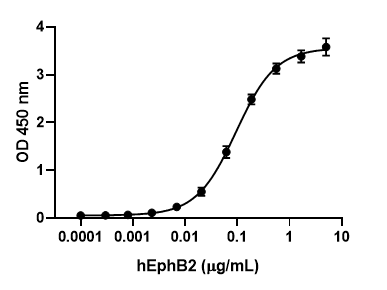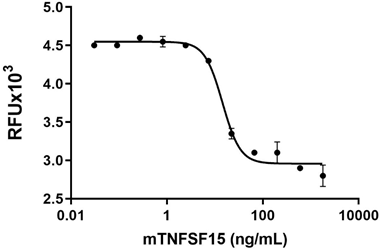- Regulatory Status
- RUO
- Other Names
- HTK Ligand, Ephrin B2, EFNB2, Eph-Related Receptor Tyrosine Kinase Ligand 5, Ligand Of Eph-Related Kinase 5, EPLG5, LERK5, HTKL
- Ave. Rating
- Submit a Review
- Product Citations
- publications

-

Immobilized recombinant human Ephrin-B2 binds recombinant human EphB2-Fc Chimera in a dose-dependent manner with an EC50 range of 10 - 40 ng/mL. -

Stability Testing for Recombinant Human Ephrin-B2. Recombinant human Ephrin-B2 was aliquoted in PBS at 0.2 mg/mL. One aliquot was frozen and thawed four times (4x Freeze/Thaw), and compared to a control kept at 4°C (Control). The samples were tested in a binding assay with recombinant human EphB2-Fc Chimera.
Ephrins are cell surface molecules with a wide variety of biological functions since they are expressed on nearly every tissue of a developing embryo while also persisting throughout adulthood. The ephrin family of ligands consists of five GPI-linked members (ephrin-A1 through A5) in addition to three transmembrane proteins (ephrin-B1 through B3). The interaction between ephrin ligands and their Eph receptors generates bidirectional signaling, affecting both receptor and ligand expressing cells, and contributes greatly to the regulation of neural crest migration, growth cone development, and cancer progression. Mature Ephrin-B2 is comprised of a 202 amino acid extracellular domain, a 21 amino acid transmembrane portion, and an 83 amino acid cytoplasmic domain. It is expressed on presynaptic neurons where it promotes presynaptic development, EphB2 shedding, and axonal guidance. Ephrin-B2 controls VEGF-induced angiogenesis and lymphangiogensis by vascular mural cells as well as arterial and lymphatic endothelium. It has also been shown to prevent the effects of NMDA receptor (NMDAR) antibodies on neuroplasticity and memory meant to treat NMDAR encephalitis. Ephrin-B2 overexpression occurs in many cancers where it promotes the metastasis, proliferation, and angiogenesis of tumors. Abnormal Ephrin-B2 upregulation has been characterized in glioblastoma, neuroblastoma, oral squamous cell carcinoma, mutant p53 colorectal carcinoma, and gastric cancers.
Product DetailsProduct Details
- Source
- Human Ephrin-B2, amino acid Lys26-Ala229 (Accession # P52799) with C-terminal 6His tag was expressed in CHO cells.
- Molecular Mass
- The 213 amino acid recombinant protein has a predicted molecular mass of approximately 23.4 kD. The DTT-reduced protein migrates at approximately 30 kD and the non-reduced protein migrates at approximately 28 kD by SDS-PAGE. The predicted N-terminal amino acid is Lys.
- Purity
- >95%, as determined by Coomassie stained SDS-PAGE.
- Formulation
- 0.22 µm filtered protein solution is in PBS, pH 7.2
- Endotoxin Level
- Less than 0.1 EU per µg protein as determined by the LAL method.
- Concentration
- 10 and 25 µg sizes are bottled at 200 µg/mL. 100 µg size and larger sizes are lot-specific and bottled at the concentration indicated on the vial. To obtain lot-specific concentration and expiration, please enter the lot number in our Certificate of Analysis online tool.
- Storage & Handling
- Unopened vial can be stored between 2°C and 8°C for up to 2 weeks, at -20°C for up to six months, or at -70°C or colder until the expiration date. For maximum results, quick spin vial prior to opening. The protein can be aliquoted and stored at -20°C or colder. Stock solutions can also be prepared at 50 - 100 µg/mL in appropriate sterile buffer, carrier protein such as 0.2 - 1% BSA or HSA can be added when preparing the stock solution. Aliquots can be stored between 2°C and 8°C for up to one week and stored at -20°C or colder for up to 3 months. Avoid repeated freeze/thaw cycles.
- Activity
- When recombinant human Ephrin-B2 is immobilized at 2 µg/mL, recombinant human EphB2-Fc Chimera binds in a dose-dependent manner. The EC50 range for this effect is 10 - 40 ng/mL. HRP Protein A (Cat. No. 689202) was used to detect the binding.
- Application
-
Bioassay
- Application Notes
-
BioLegend carrier-free recombinant proteins provided in liquid format are shipped on blue ice. Our comparison testing data indicates that when handled and stored as recommended, the liquid format has equal or better stability and shelf-life compared to commercially available lyophilized proteins after reconstitution. Our liquid proteins are verified in-house to maintain activity after shipping on blue ice and are backed by our 100% satisfaction guarantee. If you have any concerns, contact us at tech@biolegend.com.
Antigen Details
- Structure
- Monomer
- Distribution
-
Ephrin-B2 is expressed by vascular mural cells and arterial vascular and lymphatic endothelium
- Function
- Cell surface transmembrane ligand for Eph receptors, a family of receptor tyrosine kinases which are crucial for migration, repulsion and adhesion during neuronal, vascular and epithelial development.
- Interaction
- Neurons, Endothelial cells
- Ligand/Receptor
- EphA4, EphA3, EphB2, and EphB4
- Bioactivity
- Measured by its ability to bind recombinant human EphB2
- Cell Type
- Endothelial cells, Neurons
- Biology Area
- Angiogenesis, Cell Motility/Cytoskeleton/Structure, Neuroscience, Synaptic Biology
- Molecular Family
- Soluble Receptors
- Antigen References
-
- Pasquale EB. 2008. Cell. 133:38-52.
- Wilkinson DG. 2001. Nat Rev Neurosci. 2:155-64.
- Lin KT, et al. 2008. J Biol Chem. 283:28969-79.
- Foo SS, et al. 2006. Cell. 124:161-73.
- Treffy RW, et al. 2016. Dev Neurosci. 38:124-38.
- Poliak S, et al. 2015. ELife. e10841.
- Pozniak PD, et al. 2016. J Cell Physiol. 231:1237-48.
- Wang Y, et al. 2010. Nature. 465:483-6.
- Benjamin K, et al. 2016. ELife. e14845.
- Sasabe E, et al. 2017. PLoS One. 11:e0188965.
- Yue WJ, et al. 2018. Oncol Lett. 16:4455-4461.
- Thomas MG, et al. 2013. Cell Death Dis. 4:e669.
- Planagumà J, et al. 2016. Ann Neurol. 80:388-400.
- Gene ID
- 1948 View all products for this Gene ID
- UniProt
- View information about Ephrin-B2 on UniProt.org
Related FAQs
- Why choose BioLegend recombinant proteins?
-
• Each lot of product is quality-tested for bioactivity as indicated on the data sheet.
• Greater than 95% Purity or higher, tested on every lot of product.
• 100% Satisfaction Guarantee for quality performance, stability, and consistency.
• Ready-to-use liquid format saves time and reduces challenges associated with reconstitution.
• Bulk and customization available. Contact us.
• Learn more about our Recombinant Proteins. - How does the activity of your recombinant proteins compare to competitors?
-
We quality control each and every lot of recombinant protein. Not only do we check its bioactivity, but we also compare it against other commercially available recombinant proteins. We make sure each recombinant protein’s activity is at least as good as or better than the competition’s. In order to provide you with the best possible product, we ensure that our testing process is rigorous and thorough. If you’re curious and eager to make the switch to BioLegend recombinants, contact your sales representative today!
- What is the specific activity or ED50 of my recombinant protein?
-
The specific activity range of the protein is indicated on the product datasheets. Because the exact activity values on a per unit basis can largely fluctuate depending on a number of factors, including the nature of the assay, cell density, age of cells/passage number, culture media used, and end user technique, the specific activity is best defined as a range and we guarantee the specific activity of all our lots will be within the range indicated on the datasheet. Please note this only applies to recombinants labeled for use in bioassays. ELISA standard recombinant proteins are not recommended for bioassay usage as they are not tested for these applications.
- Have your recombinants been tested for stability?
-
Our testing shows that the recombinant proteins are able to withstand room temperature for a week without losing activity. In addition the recombinant proteins were also found to withstand four cycles of freeze and thaw without losing activity.
- Does specific activity of a recombinant protein vary between lots?
-
Specific activity will vary for each lot and for the type of experiment that is done to validate it, but all passed lots will have activity within the established ED50 range for the product and we guarantee that our products will have lot-to-lot consistency. Please conduct an experiment-specific validation to find the optimal ED50 for your system.
- How do you convert activity as an ED50 in ng/ml to a specific activity in Units/mg?
-
Use formula Specific activity (Units/mg) = 10^6/ ED50 (ng/mL)
 Login / Register
Login / Register 












Follow Us